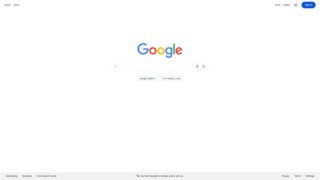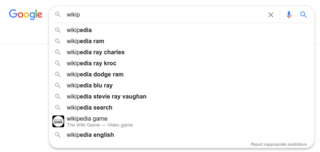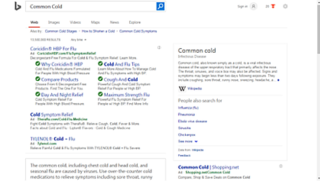
Google Search is a search engine operated by Google. It allows users to search for information on the Internet by entering keywords or phrases. Google Search uses algorithms to analyze and rank websites based on their relevance to the search query. It is the most popular search engine worldwide.

MSN is an American web portal and related collection of Internet services and apps for Windows and mobile devices, provided by Microsoft and launched on August 24, 1995, alongside the release of Windows 95.
Search engine optimization (SEO) is the process of improving the quality and quantity of website traffic to a website or a web page from search engines. SEO targets unpaid traffic rather than direct traffic or paid traffic. Unpaid traffic may originate from different kinds of searches, including image search, video search, academic search, news search, and industry-specific vertical search engines.
A query language, also known as data query language or database query language (DQL), is a computer language used to make queries in databases and information systems. In database systems, query languages rely on strict theory to retrieve information. A well known example is the Structured Query Language (SQL).
Yahoo! Search is a search engine owned and operated by Yahoo!, using Microsoft Bing to power results.
A GIS software program is a computer program to support the use of a geographic information system, providing the ability to create, store, manage, query, analyze, and visualize geographic data, that is, data representing phenomena for which location is important. The GIS software industry encompasses a broad range of commercial and open-source products that provide some or all of these capabilities within various information technology architectures.

A search engine is a software system that provides hyperlinks to web pages and other relevant information on the Web in response to a user's query. The user inputs a query within a web browser or a mobile app, and the search results are often a list of hyperlinks, accompanied by textual summaries and images. Users also have the option of limiting the search to a specific type of results, such as images, videos, or news.

Microsoft Bing, commonly referred to as Bing, is a search engine owned and operated by Microsoft. The service traces its roots back to Microsoft's earlier search engines, including MSN Search, Windows Live Search, and Live Search. Bing offers a broad spectrum of search services, encompassing web, video, image, and map search products, all developed using ASP.NET.
A search engine results page (SERP) is a webpage that is displayed by a search engine in response to a query by a user. The main component of a SERP is the listing of results that are returned by the search engine in response to a keyword query.
Windows Live Toolbar was a browser extension toolbar for Internet Explorer. It superseded MSN Search Toolbar. Windows Live Toolbar provided a simple search interface that starts to list results as the user types in a search query and uses Bing as its search engine. The toolbar also allows users to synchronize their Internet Explorer favorites across multiple computers and provides an interface to Windows Live and MSN services.

Bing Videos is a video search service and part of Microsoft's Bing search engine. The service enables users to search and view videos across various websites. Bing Videos was officially released on September 26, 2007 as Live Search Video, and rebranded as Bing Videos on June 1, 2009.

Bing Health is a health-related search service as part of Microsoft's Bing search engine. It is a search engine specifically for health-related information through a variety of trusted and credible sources, including Medstory, Mayo Clinic, National Institutes of Health's MedlinePlus, as well as from Wikipedia.

Windows Search is a content index and desktop search platform by Microsoft introduced in Windows Vista as a replacement for the previous Indexing Service of Windows 2000, Windows XP, and Windows Server 2003, designed to facilitate local and remote queries for files and non-file items in the Windows Shell and in compatible applications. It was developed after the postponement of WinFS and introduced to Windows several benefits of that platform.
Yahoo Search BOSS was a Yahoo! Developer Network initiative to provide an open search web services platform.
Yebol was a vertical "decision" search engine that had developed a knowledge-based, semantic search platform. Based in San Jose, California, Yebol's artificial intelligence human intelligence-infused algorithms automatically cluster and categorize search results, web sites, pages and contents that it presents in a visually indexed format that is more aligned with initial human intent. Yebol used association, ranking and clustering algorithms to analyze related keywords or web pages. Yebol presented as one of its goals the creation of a unique "homepage look" for every possible search term.

Facebook Graph Search was a semantic search engine that Facebook introduced in March 2013. It was designed to give answers to user natural language queries rather than a list of links. The name refers to the social graph nature of Facebook, which maps the relationships among users. The Graph Search feature combined the big data acquired from its over one billion users and external data into a search engine providing user-specific search results. In a presentation headed by Facebook CEO Mark Zuckerberg, it was announced that the Graph Search algorithm finds information from within a user's network of friends. Microsoft's Bing search engine provided additional results. In July it was made available to all users using the U.S. English version of Facebook. After being made less publicly visible starting December 2014, the original Graph Search was almost entirely deprecated in June 2019.
Example-centric programming is an approach to software development that helps the user to create software by locating and modifying small examples into a larger whole. That approach can be helped by tools that allow an integrated development environment (IDE) to show code examples or API documentation related to coding behaviors occurring in the IDE. “Borrow” tactics are often employed from online sources, by programmers leaving the IDE to troubleshoot. The purpose of example-centric programming is to reduce the time spent by developers searching online. Ideally, in example-centric programming, the user interface integrates with help module examples for assistance without programmers leaving the IDE. The idea for this type of “instant documentation” is to reduce programming interruptions. The usage of this feature is not limited to experts, as some novices reap the benefits of an integrated knowledge base, without resorting to frequent web searches or browsing.
Contextual search is a form of optimizing web-based search results based on context provided by the user and the computer being used to enter the query. Contextual search services differ from current search engines based on traditional information retrieval that return lists of documents based on their relevance to the query. Rather, contextual search attempts to increase the precision of results based on how valuable they are to individual users.

Searx is a free and open-source metasearch engine, available under the GNU Affero General Public License version 3, with the aim of protecting the privacy of its users. To this end, Searx does not share users' IP addresses or search history with the search engines from which it gathers results. Tracking cookies served by the search engines are blocked, preventing user-profiling-based results modification. By default, Searx queries are submitted via HTTP POST, to prevent users' query keywords from appearing in webserver logs. Searx was inspired by the Seeks project, though it does not implement Seeks' peer-to-peer user-sourced results ranking.









